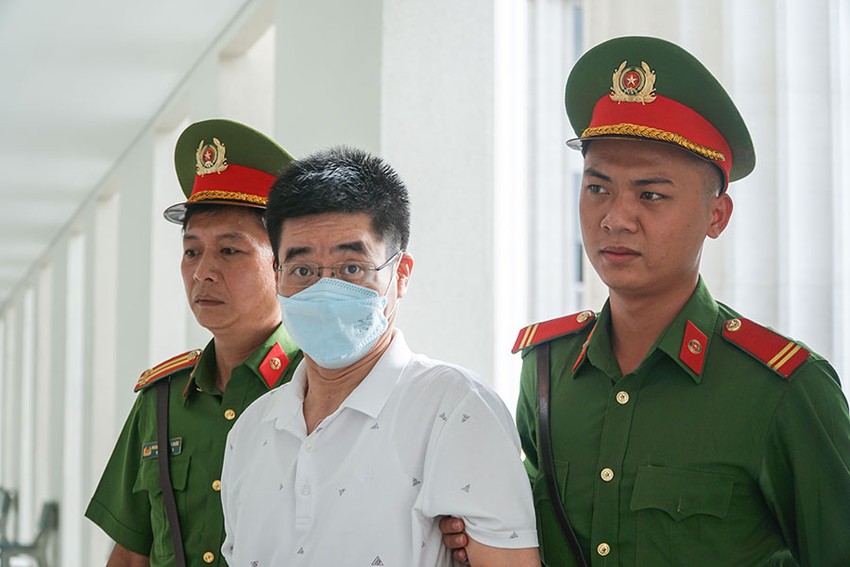In the "rescue flight" case, defendant Hoang Van Hung, former head of Division 5 of the Investigative Security Agency of the Ministry of Public Security, confirmed that he received a digital lock briefcase, but there was no $450,000 in the briefcase. The Procuracy side proved by giving testimony of the defendants who claimed to have spent money on Hung, the clip of defendant Hung receiving the briefcase, the diary of phone calls...
Defendant Tran Hung (the case of producing and trading fake textbooks) is also accused of accepting a bribe of 300 million VND. Defendant Hung did not admit this behavior, but the representative of the Procuracy said that there were enough grounds to determine that defendant Hung had received bribes...
From these two cases, many people wonder what is the convict evidence, how does the prosecution evaluate these evidences?

Defendant Tran Hung (the case of producing and trading fake textbooks) is also accused of accepting a bribe of 300 million VND. Defendant Hung did not admit this behavior, but the representative of the Procuracy said that there were enough grounds to determine that defendant Hung had received bribes...
From these two cases, many people wonder what is the convict evidence, how does the prosecution evaluate these evidences?
Defendant Tran Hung (the case of producing and trading fake textbooks) is also accused of accepting a bribe of 300 million VND. Defendant Hung did not admit this behavior, but the representative of the Procuracy said that there were enough grounds to determine that defendant Hung had received bribes...
From these two cases, many people wonder what is the convict evidence, how does the prosecution evaluate these evidences?
Full, objective, comprehensive assessment
According to MSc Nguyen Duc Hieu, International University (Vietnam National University, Ho Chi Minh City), what is not directly related, has no meaning in proving criminal acts or unreal things such as imagination, thoughts, non-existent things fact… can't be called evidence.
Not only in Vietnam but also in many countries around the world, the identification of crimes is mainly through the objective, in which the behavior, consequences and cause-and-effect relationship are the core. The objective side is what happens outside and must be associated with the consequences of the person committing the crime through behavior (action or inaction) but must leave evidence such as traces, objects. , images from the camera… Therefore, evidence and crime in criminal proceedings are two closely related categories.
According to Article 108 of the CPC, each evidence must be examined and evaluated to determine its legitimacy, authenticity and relevance to the case. The identification of collected evidences must be sufficient to settle the criminal case. In addition, all evidences collected about the case must be fully, objectively and comprehensively examined and evaluated.
There are currently no detailed guidelines for the assessment of evidence in criminal proceedings. However, other laws in the CPC itself can be applied to evaluate evidence such as Article 108 with three principles of objectivity, comprehensiveness and completeness.
Forcing or removing must be considered comprehensively
MSc Nguyen Duc Hieu Specific analysis: Objectivity is shown to be unbiased, realistically evaluated, not based on feelings, preferences or imposed thoughts.
Comprehensive is when assessing evidence must be appropriate, must consider all evidence, cannot consider the confession of the accused, the accused as the only evidence of accusation. According to Clause 2, Article 98 of the Criminal Procedure Code, a guilty plea can only be considered as evidence if it is consistent with other evidences of the case.
For example, defendant Hoang Van Hung pleaded not guilty and said that he only received a digital key bag containing four bottles of wine, not $ 450,000. In this case, not only should we consider the testimony of defendant Hung, but also consider whether that testimony is consistent with the testimonies of other defendants, evidence from cameras, phone calls, etc.
Sufficient evidence, that is, to consider the evidence from beginning to end, to read it all, to see it all and not to omit it; If new evidence is presented at the court hearing, that evidence must also be evaluated.
According to Master Hieu, in addition to applying other laws in the Criminal Procedure Code itself, the same law can be applied under Resolution 04/2012/NQ-HDTP on collecting evidence, taking testimony...
Principles of evaluating evidence
Clause 1, Article 87 of the CPC also stipulates: Sources of evidence are physical evidence; testimonies, presentations; Electronic data; conclusions on property assessment and valuation; minutes in prosecution, investigation, prosecution, trial, etc.
Evaluating evidence to clarify the probative value of each evidence for determining the nature of the legal relationship to be resolved. Therefore, the evaluation of evidence should follow principles to ensure that the attributes of evidence include objectivity, legitimacy, and relevance.
Direct has higher value than indirect
According to a judge in Ho Chi Minh City, evidence has attributes such as objectivity, probative value and is collected in accordance with the legal order. Classification of evidence includes: direct, indirect; original, narrated; exhibits and witnesses; speaking and writing.
Usually direct evidence is more valuable than indirect evidence. In cases where direct evidence cannot be collected, indirect evidence shall be collected and used. Through indirect evidence comes to a conclusion that is equivalent to direct evidence, only indirect evidence is valid.
Original evidence is always more accurate than narrative evidence. Evidence is always more valuable than witnesses, because evidence after birth does not change, and witnesses can change. The further away from the source, the less reliable evidence is reported, and written evidence is more valuable than oral evidence.
Besides, the ancients have a saying "one witness is worthless", so it is often necessary to have two independent pieces of evidence to check the reliability of the evidence, to confirm the accuracy of the evidence. Considering the reliability of the evidence source, the reliability of the evidence provider, the time and place of the evidence appearance, the circumstances of the evidence presentation.
The consideration and evaluation of incriminating evidence and exculpatory evidence must be given equal attention, not only paying attention to incriminating evidence and disregarding exculpatory evidence. Evidence must be viewed in relation to one another, without taking a metaphysical point of view in the assessment of evidence. Evidences generated from a single root are not mutually exclusive.
Both incriminating and exonerated evidence must be assessed
A judge who has worked in Ho Chi Minh City for many years acknowledged that an inaccurate assessment of evidence could very well lead to injustice. Typically, the unjust case of Mr. Bui Minh Hai in Dong Nai. At that time, the People's Procuracy of Dong Nai province had a recognition of the errors: The prosecutor did not fulfill his responsibilities, did not detect any contradictions in the file.
The investigator investigated with a subjective orientation, identifying Mr. Hai as the culprit; take testimonies from witnesses, focus on the direction related to Mr. Hai, do not put forward other hypotheses.


Post a Comments